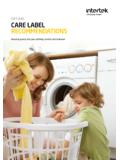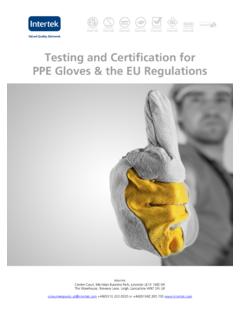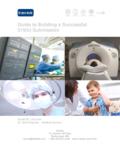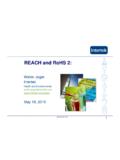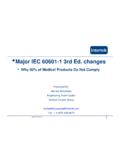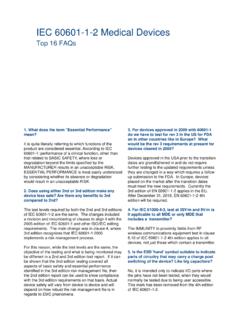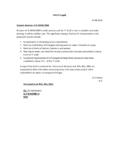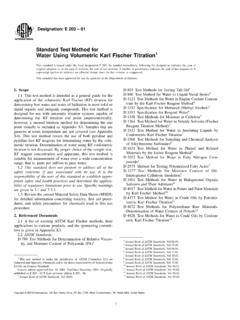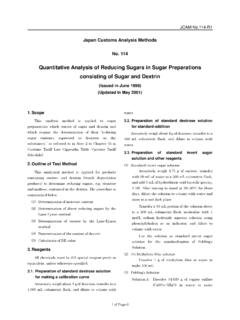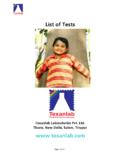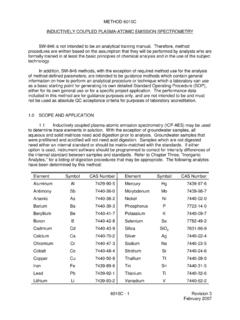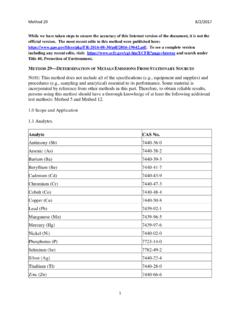Transcription of White Paper Title - Intertek
1 Intertek Centre Court, Meridian Business Park, Leicester, LE19 1WD, UK EN71-3: Revised chemical migration limits for toys 0116 263 0330 Understanding EN 71-3: Chemical migration limits Contents 1 1 2 EN 3 Challenges and 4 Alternatives to traditional test based 5 Implications for products other than 6 7 How can Intertek help?.. 7 EN 71-3 First Action/Combined Migratable Screening:.. 7 EN 71-3 Risk Assessment:.. 8 Introduction On the 20th July 2009 the first major revision for over twenty years took effect on the European Toy Safety Directive (2009/48/EC). While most of the requirements of the revision applied to products from 20th July 2011, the chemical aspects, including the migration limits for various elements, actually apply to products first placed on the market from July 20th 2013. As a result of the change in the legislation, a revision to the EN 71-3 Standard has been developed by the CEN/TC52/WG5 committee working group, which has implications for toys and (indirectly) for child care articles and pencil/graphic instruments placed on the EU market.
2 The standard has now been approved and published by EU member state standards bodies, BSI. This Paper will discuss the changes and implications for such products placed on the EU market from this summer, helping manufacturers, importers and retailers understand the obligations that they will need to consider in their compliance plans. 1 Understanding EN 71-3: Chemical migration limits Background The previous European Directive on toy safety (88/378/EEC) laid down bioavailability limits in microgrammes per day for eight elements (lead, cadmium, chromium, barium, arsenic, selenium, antimony and mercury). This was converted in the EN 71-3 standard to soluble element migration in mg/kg of the element in the toy material based on an assumed ingestion by a child of 8 mg/day of toy material. Because of the statistical variation between different laboratories results an analytical correction factor was included in the standard to be applied when an analytical result equals or exceeds the maximum limit.
3 2009/48/EC took a different approach and defined the migration limits for each element within the directive itself. This was as a result of work done for the European Commission on the toxicological aspects of such elements in toys. This work also resulted in additional elements being restricted as well as organic tin compounds and differentiating between chromium III and chromium VI. A further change was the introduction of different limits based on the varying degree of ingestion of different types of material. The material types are classified as follows: Category I dry, brittle, powder like or pliable material chalk, modelling dough Category II liquid or sticky bubble solution, liquid paints, glue sticks Category III scraped off toy material plastic, paint coatings, textile The table below shows the comparison between the new and existing limits in the previous EN 71-3. All limits are in mg/kg (equivalent to parts per million or ppm).
4 Element Cat I Cat II Cat III Previous EN 71-3 Antimony 45 560 60 Arsenic 47 25 Barium 1500 375 18750 1000 Cadmium 17 75 Chromium (III) 460 60 Lead 160 90 Mercury 94 60 Selenium 460 500 2 Understanding EN 71-3: Chemical migration limits Under article 46 of 2009/48/EC the migration limits can be amended under a process known as comitology and in fact this has already happened in the case of cadmium by directive 2012/7/EU and in the case of barium by EU Regulation 681/2013 (the above table incorporates these changes).
5 Similar changes are expected in the near future for lead. The other limits for the new elements and chemicals are detailed below: Element Cat I Cat II Cat III Aluminium 5625 1406 70000 Boron 1200 300 15000 Chromium (VI) Cobalt 130 Copper 156 7700 Manganese 1200 300 15000 Nickel 75 930 Strontium 4500 1125 56000 Tin 15000 3750 180000 Organic tin 12 Zinc 3750 938 46000 EN 71-3 The scope of the amended standard remains basically unchanged and reflects the scope of the directive in this respect.
6 These limit values shall not apply to toys or components of toys which, due to their accessibility, function, volume or mass, clearly exclude any hazard due to sucking, licking, swallowing or prolonged contact with skin . It therefore applies to accessible parts of toys intended to be put in the mouth, cosmetic toys and writing instruments such as pens and crayons as these are likely to lead to ingestion of toy materials regardless of the age of the child. The standard suggests that the likelihood of mouthing toys reduces from the age of 6 years of age. The basic method for extraction is also unchanged. A test portion is taken from each toy component or material and is mixed with 50 times its mass of hydrochloric acid. It is shaken in the dark for one hour at 37oC and then left to stand for a further hour. This process represents the process in a child s stomach. 3 Understanding EN 71-3: Chemical migration limits The resulting solution is then subject to chemical analysis to determine the amounts of each element which have dissolved into the acid from the toy material.
7 This is known as the soluble or migrateable amount as distinct from the total amount of the element which is sometimes required in the US under CPSIA and would involve the total dissolution of the toy component using concentrated acid. The revised EN 71-3 will not include analytical correction factors. Challenges and approaches Although the basic methodology has not changed for 17 of the 19 elements there are a number of challenges arising from the new requirements and revised EN 71-3 standard. These include: Lower limits generally, particularly for categories I and II. Differentiation between chromium III and chromium VI. Low limits for chromium VI in categories I and II. Organic tin compliance. Removal of analytical correction factors. Demonstrating compliance for toys placed on the EU market from 20 July 2013. The first of these issues is not a major problem in terms of analytical capability since modern ICP-MS instruments are able to work to much lower detection limits than the older AA or even ICP-OES instruments that were often used for testing to the previous standard.
8 However the lower limits being proposed for lead for example could present challenges in sourcing suitable materials in those toys which contain raw materials of natural origin such as clays. The listing of elements not previously restricted may result in failures for some materials which in the past have complied with EN 71-3, this is particularly the case for art and craft materials in categories I and II one potential example being the use of aluminium based pigments in silver paints. The issue of chromium VI has been highlighted from before the publication of the directive as being a potential challenge. Firstly it requires a separate type of analysis in addition to the normal analysis for migration of chromium since it needs to differentiate between the two forms of chromium. While it is possible to carry out this analysis for category III materials it has not been possible for CEN to 4 Understanding EN 71-3: Chemical migration limits publish a method for category I and II materials because of the second problem, that of extremely low limits (although laboratories are developing their own in-house methods).
9 As a result the standard suggests alternative approaches to demonstrate compliance for these materials, such as safety assessment of the toy material. Even for category III materials the additional analysis is expensive and actually unnecessary for most toy materials and it is likely that many manufacturers will adopt alternative approaches mentioned in the standard which are often referred to as first action or screening methods. These include the determination of the migration of combined chromium migration of chromium III + chromium VI. This approach relies on showing that migration of combined chromium is less than the limit for chromium VI. A similar approach can also be used to demonstrate compliance for organic tin which again is an expensive and often unnecessary analysis . By determining the migration of tin and comparing the result to the organic tin limit then compliance can be inferred.
10 However with organic tin there is an additional problem. The requirement in the Toy Safety Directive is for the total migration of all organic tin. The migration of organic tin is calculated by adding the migration values for all the single organic tin compounds that have been detected but the method only lists ten compounds as examples and it acknowledges that other organic tin compounds may be present. This problem can also be addressed by the screening approach previously described. The fact that analytical correction factors have not been included in the revised EN 71-3 has focussed attention on the performance of laboratories. The initial round robin trial showed some shortcomings in the method and significant variation in results between laboratories. As a result a laboratory s measurement uncertainty may become more important in determining whether a result complies with the standard, however since accredited laboratories are required to determine their own performance data, including measurement uncertainty this information should be available.

